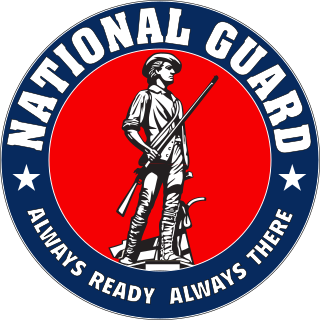
The National Guard is a state-based military force that becomes part of the reserve components of the United States Army and the United States Air Force when activated for federal missions. It is a military reserve force composed of National Guard military members or units of each state and the territories of Guam, the Virgin Islands, Puerto Rico, and the District of Columbia, for a total of 54 separate organizations. It is officially created under Congress's Article 1 Section 8 ability to "raise and support armies". All members of the National Guard are also members of the organized militia of the United States as defined by 10 U.S.C. § 246. National Guard units are under the dual control of state governments and the federal government.

The Posse Comitatus Act is a United States federal law signed on June 18, 1878, by President Rutherford B. Hayes which limits the powers of the federal government in the use of federal military personnel to enforce domestic policies within the United States. Congress passed the Act as an amendment to an army appropriation bill following the end of Reconstruction and updated it in 1956, 1981 and 2021.
The United States has eight federal uniformed services that commission officers as defined by Title 10 and subsequently structured and organized by Titles 10, 14, 32, 33 and 42 of the U.S. Code.
The Uniform Code of Military Justice (UCMJ) is the foundation of the system of military justice of the armed forces of the United States. The UCMJ was established by the United States Congress in accordance with their constitutional authority, per Article I, Section 8, which provides that "The Congress shall have Power. .. to make Rules for the Government and Regulation of the land and naval forces" of the United States.

The United States Department of the Army (DA) is one of the three military departments within the Department of Defense of the U.S. The Department of the Army is the federal government agency within which the United States Army (U.S.) is organized, and it is led by the secretary of the Army, who has statutory authority under 10 United States Code § 7013 to conduct its affairs and to prescribe regulations for its government, subject to the limits of the law, and the directions of the secretary of defense and the president.
Title 21 of the United States Code governs Food and Drugs in the United States Code (U.S.C.).
Title 6 of the United States Code is a non-positive law title of the United States Code that governs Domestic Security.
Title 14 of the United States Code is a positive law title of the United States Code concerning the United States Coast Guard.
Title 16 of the United States Code outlines the role of conservation in the United States Code.
In the United States Code, Title 17 outlines its copyright law. It was codified into positive law on July 30, 1947. The latest version is from December 2016.
Title 20 of the United States Code outlines the role of education in the United States Code.
Title 23 of the United States Code is a positive law title of the United States Code with the heading "Highways."
Title 24 of the United States Code outlines the role of hospitals and psychiatric hospitals in the United States Code.
Title 25 of the United States Code outlines the role of Indians in the United States Code.
Title 27 of the United States Code outlines the role of intoxicating liquors in the United States Code.
Title 30 of the United States Code outlines the role of mineral lands and mining in the United States Code.
Title 31 of the United States Code outlines the role of the money and finance in the United States Code.
Title 33 of the United States Code outlines the role of navigable waters in the United States Code.
Title 37 of the United States Code outlines the role of Pay and Allowances of the Uniformed Services in the United States Code.
Title 43 of the United States Code outlines the role of Public Lands in the United States Code.
This page is based on this
Wikipedia article Text is available under the
CC BY-SA 4.0 license; additional terms may apply.
Images, videos and audio are available under their respective licenses.



